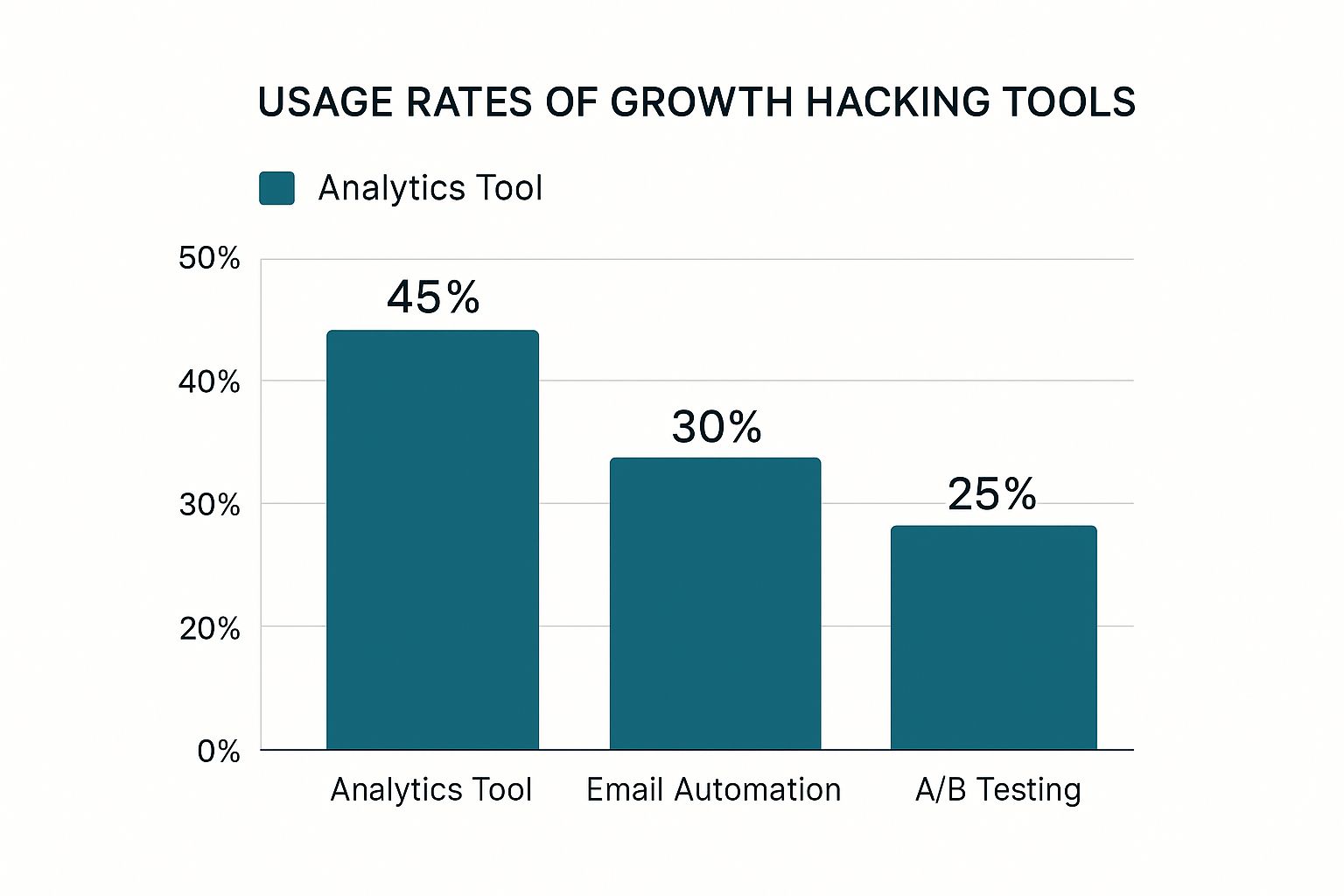
Growth hacking isn't a magic trick. It's a mindset. Forget big budgets and bloated marketing teams. As founders, we have one job: find the most efficient, scalable ways to grow our company, period. It's about using our product, our data, and our brains to move the needle, instead of just throwing money at ads.
This means breaking down the walls between marketing, product, and engineering. Growth isn't a marketing task; it's a company-wide obsession. When you're bootstrapped or running on fumes, you can't afford to wait years for brand campaigns to pay off. You need to run small, fast, measurable experiments, find what works, and double down. Fast.
A Mindset Obsessed with Scalable Growth
So what does that actually look like day-to-day? It’s about breaking down the walls between departments. Your engineers, product managers, and marketers all unite around a single, shared mission: growth. Traditional marketing often stays in its lane, but growth hacking sees the product itself as your best marketing asset. Growth isn't just about running ads; it's baked right into the user experience.
This shift is a lifeline for startups. When you’re short on cash and time, you have to be ruthless about where you focus. You simply can't afford to place big bets on slow, pricey brand-building campaigns that might take years to pay off. Instead, you run a series of small, fast, measurable experiments to find out what actually works, and then you pour your resources into that.
More Than Just a Marketing Checklist
The real difference is in the scope of thinking. A traditional marketer might be tasked with driving traffic to a landing page. A growth hacker, on the other hand, is looking at the entire customer journey from start to finish. They’re constantly asking questions like:
- Acquisition: What’s the cheapest, most scalable channel we can find to bring in new users?
- Activation: How can we tweak the onboarding process to get a new user to that "Aha!" moment in seconds, not minutes?
- Retention: What simple feature could we build that would make our product so sticky people couldn’t imagine leaving?
The Wikipedia entry on growth hacking traces its roots back to the startup scene, where this agile, scrappy approach was born out of pure necessity.

The big idea here is that growth hacking wasn’t invented in a boardroom. It was forged in the trenches by teams who needed to achieve massive growth without a massive budget, blending sharp analytical thinking with creative product ideas.
As founders, we have to think this way. It’s not about having a huge marketing department; it’s about empowering your product and engineering teams to build growth directly into what you offer. A referral program, for instance, is an engineering task with a marketing outcome. That's the essence of growth hacking.
To really nail down the difference, it helps to see the core philosophies side-by-side.
Growth Hacking vs Traditional Marketing Mindset
| Aspect | Growth Hacking | Traditional Marketing |
|---|---|---|
| Primary Goal | Scalable, rapid, and sustainable user growth. | Brand awareness, lead generation, and sales. |
| Focus Area | The entire user lifecycle (AARRR funnel). | Top of the funnel (awareness and acquisition). |
| Methods | Rapid experimentation, A/B testing, data analysis. | Campaign-based strategies, established channels. |
| Team Structure | Cross-functional (product, engineering, marketing). | Siloed marketing department. |
| Budget | Lean, low-cost, and focused on ROI. | Often large and pre-allocated to campaigns. |
| Risk Tolerance | High; failure is seen as a learning opportunity. | Low; focus is on proven, predictable outcomes. |
Ultimately, it's a fundamental difference in how you approach the problem of growth. One is a playbook; the other is a lab.
The Scrappy Origins of the Growth Hacking Movement
To really get what growth hacking is all about, you have to look at where it came from. This isn't some concept that was cooked up in a business school classroom or a corporate boardroom. It was born in the trenches of early Silicon Valley startups—the ones with big ideas but practically zero cash.
These companies were trying to change the world but had nothing to spend on the usual marketing playbook. Dropping millions on TV commercials or splashy ad campaigns was a complete non-starter. They had to get creative. This environment forced founders and their tiny teams to treat growth less like a marketing task and more like a technical problem that could be solved with clever experiments and hard data.
Giving a Name to a New Kind of Marketer
The movement finally got its name thanks to Sean Ellis. While working to scale several startups, he hit a wall: he couldn't find the right person for the job. He didn't need a classic Vice President of Marketing who was great at managing budgets and building brands. He needed someone with a single-minded, almost obsessive focus on one thing: growth.
So, in 2010, he came up with the term "growth hacker." It perfectly described this new type of professional who could help a young company get users on a shoestring budget. Ellis understood that a traditional marketer's skills often didn't translate well to the chaotic, do-or-die world of a startup. What he needed was someone who lived and breathed data, experimentation, and relentless iteration. For a deeper dive into these origins, the Wikipedia page for growth hacking is a great resource.
The Trailblazers Who Hacked Their Way to Success
The best way to understand this mindset is to look at the companies that pioneered it. They didn't just market their products; they wove growth mechanics right into the fabric of the user experience itself.
Dropbox: Instead of pouring money into ads, Dropbox built one of the most famous referral programs ever. They gave free storage space to both the person referring and their friend who signed up. This wasn't just a side campaign—it was a core product feature that turned their entire user base into a volunteer sales force.
Airbnb: Early on, Airbnb had the classic chicken-and-egg problem. They needed hosts to get travelers, but they needed travelers to attract hosts. Their ingenious solution? They created a simple tool that let hosts automatically cross-post their Airbnb listings to Craigslist, tapping into a huge, ready-made audience with almost no effort.
These stories perfectly capture the growth hacking ethos. It’s about being scrappy and analytical, using the product itself as your main engine for growth, and recognizing that the most effective marketing often doesn't look like marketing at all. It’s about solving the growth puzzle with brains, not just budget.
Inside Our BillyBuzz Growth Hacking Playbook
Theory is great, but let's get practical. At BillyBuzz, growth hacking is our daily bread. It’s not about finding one magic "hack"—it's about building a repeatable system to find customers.
Our entire process starts with one thing: listening. We find where our ideal customers (startup founders, marketers) hang out online and listen to their unfiltered pain points. No guessing.

Step 1: Find the Pain (Our Exact Sources & Filters)
We monitor specific online communities every day, not to sell, but to understand.
- Subreddits We Live In:
r/SaaS,r/startups,r/marketing,r/EntrepreneurRideAlong. These are goldmines for raw conversations about customer acquisition struggles. - Our BillyBuzz Alert Rules: We set up alerts that email us instantly when people mention buying-intent keywords. These are our actual filters:
"how to get first customers""find users on reddit""alternative to [competitor name]""I'm struggling with lead gen"
- Customer Feedback: Every support ticket or onboarding call is a clue. If three people ask for the same feature, it's not a coincidence; it's a priority.
This firehose of real-world problems fuels our entire growth engine. We don't brainstorm in a vacuum; the market tells us what to build and where to engage.
Step 2: From Insight to Action (Our Outreach Template)
When we get an alert and spot a relevant conversation, we don’t pitch. We help. This approach has landed us our most loyal early users.
Here’s our go-to response template, which we adapt for Reddit, Slack, etc.:
"Hey [Name], saw you're struggling to find early users. It's a grind. We actually built a tool at BillyBuzz to monitor Reddit for these exact conversations because we had the same problem. Not pitching you, just wanted to let you know a solution exists. Happy to share what we've learned either way. Keep at it."
Why it works: It’s empathetic, offers value (validation that their problem is real and solvable), and opens a door without being pushy. It frames us as fellow founders, not just another vendor. To see more on how to build out these systems, you can check out our guide on Growth Loops.
Using The Pirate Funnel To Find Your Growth Leaks
If you want to be effective at growth hacking, you need a map. Just throwing dozens of tactics at the wall to see what sticks is a recipe for burning through your cash and your sanity. For us, and for many of the best growth teams out there, that map is the AARRR Pirate Funnel.
It's a brilliantly simple model that helps you diagnose your entire customer journey, breaking it down into five clear stages: Acquisition, Activation, Retention, Referral, and Revenue. By looking at your business through this lens, you can spot exactly where you're losing people—the "leaks" in your funnel. This data-driven approach stops the guesswork and lets you focus your energy where it will make a real difference.
Acquisition: Where Do Users Come From?
This is the very top of your funnel. The fundamental question you need to answer is: how are people finding out about us? So many founders fall into the trap of trying to be everywhere at once—SEO, social media, paid ads, you name it.
The growth hacker's way is different. It’s about finding the one or two channels that are genuinely working for you and then pouring all your resources into them.
For example, at BillyBuzz, we quickly realized that Reddit was our goldmine. Our ideal customers—startup founders and indie hackers—were already there, talking about the exact problems our tool solves. So, we built our entire growth strategy around that one channel. If you're looking for that first foothold, we've broken down our exact process in this guide on how to get customers from Reddit in 2025.
Activation: How Quickly Do They See Value?
Getting someone to sign up is only half the battle. If they don't get what your product does right away, they're gone. Activation is all about that initial experience. You have to ask yourself: do users have a great first impression?
The goal is to get them to their "Aha!" moment—that flash of understanding where they see the core value—as fast as humanly possible. For a tool like ours, that moment is when a user sets up their first keyword alert and gets a genuinely useful notification. For a project management app, it might be creating their first to-do list and assigning it to a team member.
A common mistake is assuming your product is so intuitive it doesn't need any guidance. The reality is that a simple onboarding checklist or a few well-placed tooltips can boost your activation rate by 20-30%. It’s about leading users straight to the magic.
Retention: Do They Keep Coming Back?
This is where real, sustainable growth is built. After all, it costs far less to keep a happy customer than it does to find a new one. The question here is brutally simple: are people actually returning to use your product?
Sending a generic weekly newsletter isn't enough. True retention means baking "stickiness" directly into your product. This could be anything from daily email digests that provide real value, to in-app notifications about critical events, to building features that become an indispensable part of a user's daily workflow.
This chart shows some of the tools growth hackers lean on to measure and improve these kinds of metrics.

It’s no surprise that analytics tools top the list. You can't improve what you don't measure, and understanding user behavior is the foundation of the entire funnel.
Referral And Revenue: The Final Steps
Finally, we get to the last two stages, which are the ultimate proof of a great product.
First, do your users love what you've built enough to tell their friends about it (Referral)? This is about turning customers into advocates. Think of Dropbox's legendary "get more free space for inviting a friend"—that’s building virality right into the product experience.
And second, are they willing to open their wallets (Revenue)? This is the moment of truth. It tells you whether you've truly solved a painful enough problem that people are willing to pay for the solution.
The AARRR funnel provides a clear, stage-by-stage framework for understanding your customer's journey. Let's break it down into a simple table.
AARRR Funnel Stages and Key Growth Metrics
| Funnel Stage | Key Question | Example Metrics |
|---|---|---|
| Acquisition | Where are new users coming from? | Traffic by channel, Cost Per Acquisition (CPA), Sign-ups |
| Activation | Are users having a great first experience? | Onboarding completion rate, "Aha!" moment conversion, Time-to-value |
| Retention | Are users coming back over time? | Daily/Monthly Active Users (DAU/MAU), Churn rate, Customer Lifetime Value (CLV) |
| Referral | Are users telling others about us? | Net Promoter Score (NPS), Viral coefficient (K-factor), Referral sign-ups |
| Revenue | Are we making money? | Monthly Recurring Revenue (MRR), Average Revenue Per User (ARPU), Conversion to paid |
By systematically analyzing each of these stages, you stop flying blind. You can plug the leaks, double down on what works, and build a truly scalable engine for growth.
Why Your Whole Team Needs to Think Like a Growth Hacker
It's one of the biggest mistakes a founder can make: fencing off "growth" and keeping it locked inside the marketing department. When you do that, you’re leaving your most powerful growth levers on the table, completely untouched.
Real growth hacking isn't a marketing campaign. It's a team sport. It demands the full brainpower of your product, engineering, and data teams working in concert.
The simple truth is that your most powerful growth opportunities live inside the product itself, not in an ad campaign. Your marketing team, on their own, can't build a viral referral loop. But your engineers can. Marketers can't single-handedly redesign the user onboarding flow to skyrocket activation rates. That's a job for your product and design team.

Unlocking Product-Led Growth
Think about the most legendary growth hacks. They were almost always engineering feats that produced a marketing result. Dropbox’s famous referral program is the classic example. Their initial explosion wasn't fueled by a clever ad; it was driven by a simple, elegant feature that gave users free storage for inviting friends.
Just like that, they turned their entire user base into a motivated sales force.
That’s the heart of the growth hacking mindset: treating your product as your number one marketing channel. Every feature, every screen, and every interaction is an opportunity to drive acquisition, activation, or retention.
When your entire company starts seeing the world this way, something special happens. Engineers start brainstorming how a small tweak to an API could increase shares. Product managers obsess over data to pinpoint the exact "Aha!" moment in the user journey. The whole organization rallies around one shared goal: growth.
Building a Culture of Growth
Getting there requires a real shift in thinking. It’s about tearing down the walls between departments and creating a shared language built on experimentation and data.
Here’s how to start embedding this mindset across your organization:
- Make Growth a Company-Wide KPI: Don't just hold the marketing team accountable for user numbers. Make key growth metrics—like activation rates or retention cohorts—a visible and shared goal for everyone, including product and engineering.
- Create Cross-Functional "Growth Squads": Put together small, dedicated teams with a mix of skills—an engineer, a marketer, a designer—and give them the autonomy to run fast experiments. This structure naturally forces collaboration and speeds up the test-and-learn cycle.
- Celebrate the Learnings, Not Just the Wins: Not every experiment will be a home run, and that's perfectly fine. The real goal is to learn as quickly as possible. When you celebrate the insights gained from a "failed" test, you create a culture where people aren't afraid to take smart risks.
When growth becomes everyone's job, you stop chasing one-off tactics and start building a self-sustaining engine for success. That collaborative spirit is what truly separates a real growth hacking strategy from just another marketing plan.
How Growth Hacking Makes The Most of a Small Budget
When you're a founder, every single dollar counts. This is where the whole idea of growth hacking really comes into its own. Instead of throwing a huge chunk of cash at a single, high-stakes ad campaign, a growth hacker makes dozens of small, calculated bets to see what actually moves the needle.
This entire approach is built on capital efficiency. You're not trying to outspend the competition; you're trying to out-think and out-learn them. Every small experiment—whether it's trying new ad copy, tweaking a subject line, or testing a different content format—is designed to teach you something valuable without risking the entire budget.
Small Bets, Big Wins
The strategy is beautifully simple: test cheaply, learn quickly, and then pour your resources into what’s proven to work. It's an agile way of working that lets you uncover scalable growth channels before your competitors even realize they're there. This is a world away from the "go big or go home" mindset of old-school marketing.
Growth hacking is all about finding those clever, high-impact strategies that deliver huge results from minimal investment. A perfect example is using programmatic SEO to scale up content creation. You can find some incredible strategies for rapidly scaling SEO content and doubling organic traffic using this very method. This isn't about being cheap; it's about being incredibly smart with the resources you have to build a growth machine that lasts.
The numbers back this up. Growth hacking campaigns can deliver serious returns for a tiny fraction of what traditional marketing costs—often less than 20% of what a big campaign would require. That’s because the focus is on targeted digital experiments, not expensive billboards or TV ads. You can dig deeper into the cost-effectiveness of these strategies on fiveable.me.
Practical, Low-Cost Growth Tactics
So, what does this look like in the real world? At BillyBuzz, we live by this. We focus on high-leverage activities that don't need a huge budget to get started.
- Content Repurposing: We take successful Reddit threads and turn them into blog posts, social media content, and more. This lets us create evergreen SEO assets from conversations we already know people care about. We wrote a whole guide on how to turn Reddit posts into evergreen SEO for your startup.
- Community Engagement: Forget paying for ads. We spend our time in communities like
r/SaaS, offering real help and building genuine relationships. Those relationships naturally turn into sign-ups and loyal customers. - Product-Led Virality: We build features directly into our product that encourage users to spread the word for us, like shareable reports or super-simple team invites.
For any early-stage founder, this mindset is a survival tool. It forces you to find the most direct path from your limited resources to real, sustainable growth. It makes sure every dollar you spend is a dollar spent on learning and scaling.
Ready to stop guessing and start growing? BillyBuzz is the AI-powered tool that finds you customers on Reddit. Automate your social monitoring, get real-time alerts on sales opportunities, and save hours of manual work. Find your first paying customers today at https://www.billybuzz.com.
